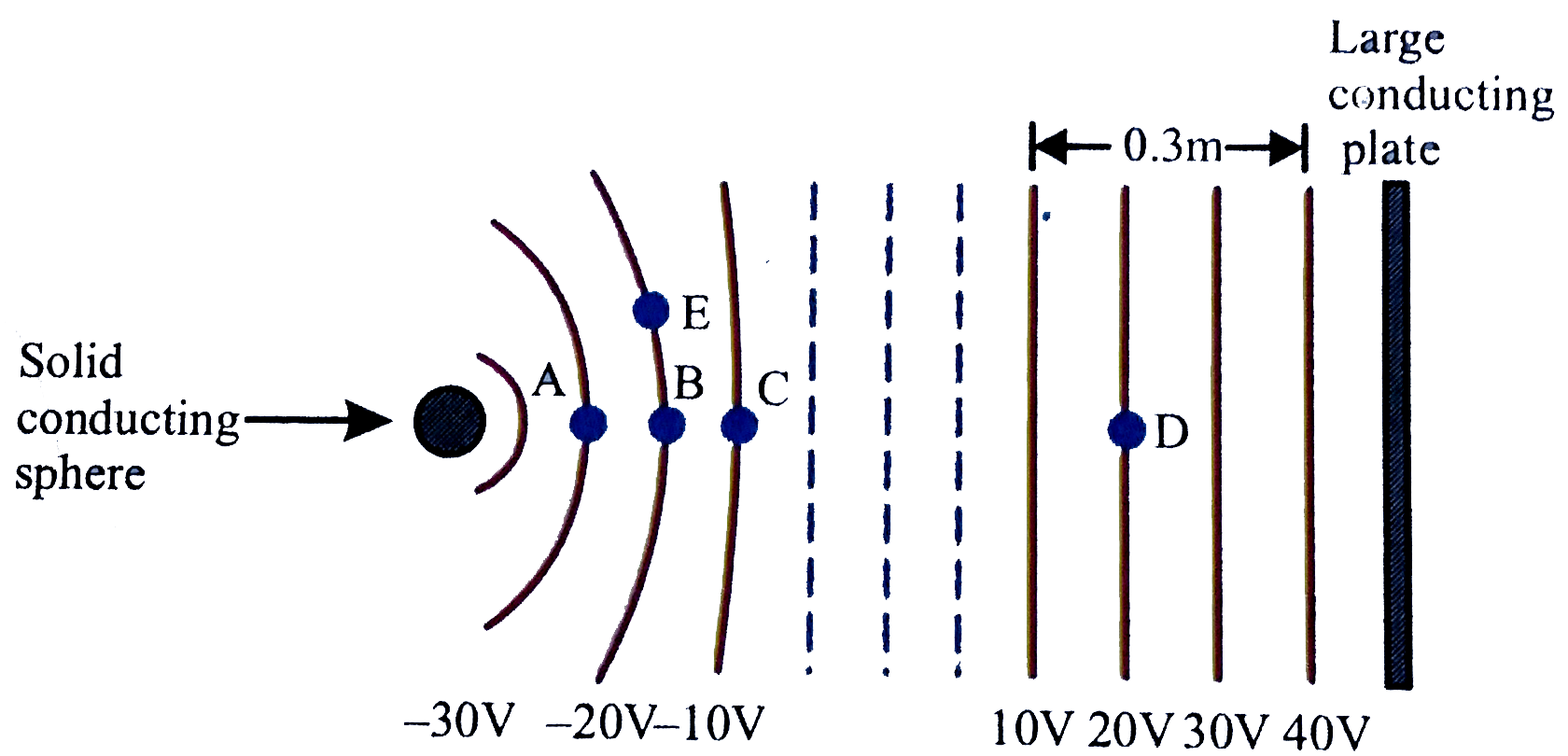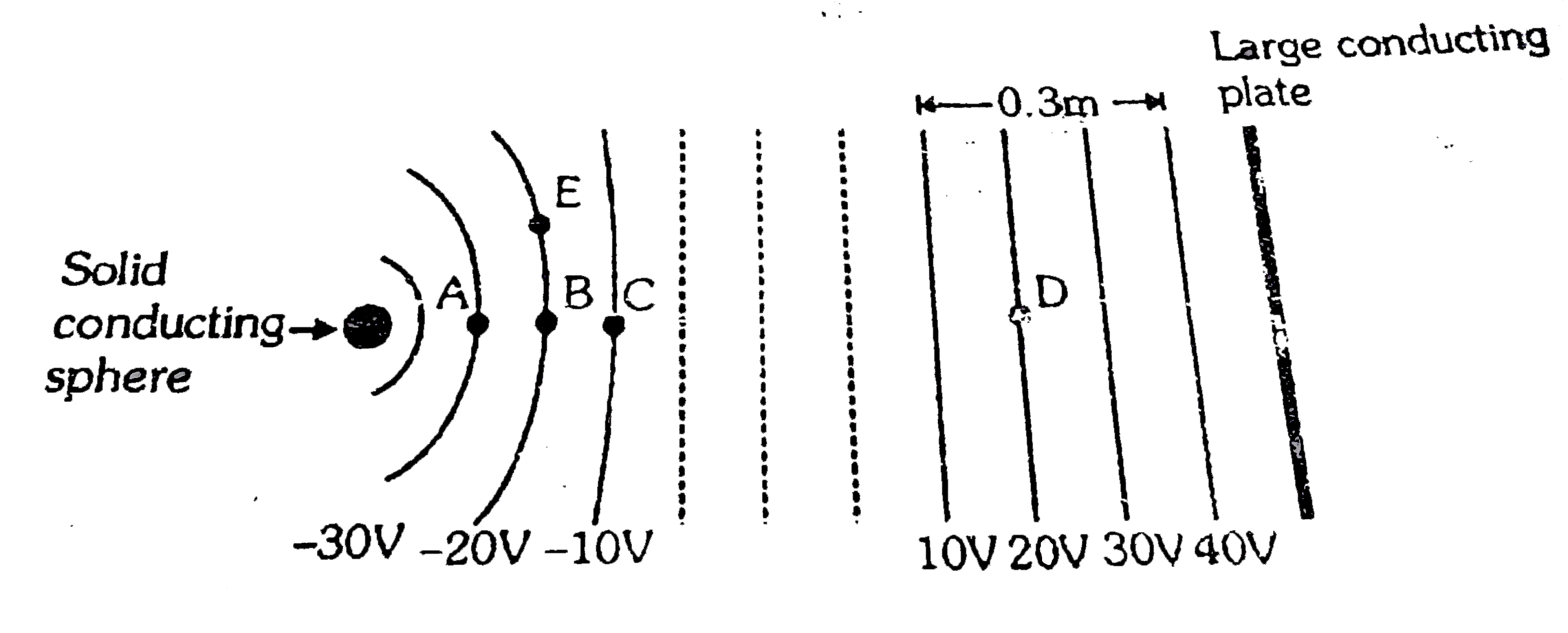The sketch below show cross section so equipotential surfaces between two charged.Conductors that are shown in solid black.Some points on the equipotenital surfaces .near the conductors are marked as A,B,C….. The arrangements lies in air (Take ε0=8.85×10−12C2/Nm2]
![The sketch below show cross section so equipotential surfaces between two charged.Conductors that are shown in solid black.Some points on the equipotenital surfaces .near the conductors are marked as A,B,C…. . The arrangements lies in air (Take epsilon(0)=8.85xx10^(-12)C^(2)//Nm^(2)] Surfaces charge density of the plate is equal to](https://d10lpgp6xz60nq.cloudfront.net/physics_images/NAR_PHY_XII_V02_C02_E01_387_Q01.png)
Surfaces charge density of the plate is equal to Solution in Gujrati
8.85×10−10C/m2
−8.85×10−10C/m2
17.7×10−10C/m2
−17.7×10−10C/m2
The correct Answer is:A
E=−dVdr,σ∈0=−300.3
σ=8.85×10−12×102=8.85×10−10C/m2
Topper's Solved these Questions
- MISCELLANEOUSBOOK - ALLEN CHAPTER - MISCELLANEOUSEXERCISE - Comprehension 7
3 Videos
- MISCELLANEOUSBOOK - ALLEN CHAPTER - MISCELLANEOUSEXERCISE - Comprehension 8
4 Videos
- MISCELLANEOUSBOOK - ALLEN CHAPTER - MISCELLANEOUSEXERCISE - Comprehension 5
5 Videos
- KINEMATICS (MOTION ALONG A STRAIGHT LINE AND MOTION IN A PLANE)BOOK - ALLEN CHAPTER - KINEMATICS (MOTION ALONG A STRAIGHT LINE AND MOTION IN A PLANE)EXERCISE - BEGINNER S BOX-7
8 Videos
- PHYSICAL WORLD, UNITS AND DIMENSIONS & ERRORS IN MEASUREMENT BOOK - ALLEN CHAPTER - PHYSICAL WORLD, UNITS AND DIMENSIONS & ERRORS IN MEASUREMENT EXERCISE - EXERCISE-IV
7 Videos
Similar Questions
The method of electrical images is used to solve the electrostatic problems, where charge distribution is not specified completely. The method consists of replacement of given charge distribution by a simplified charge distribution or a signal point charge or a number of point charges [rovided the original boundary conditions are still satisfied. For example consider a system consider a system containing a point charge q placed at a distance d of form an infinite conducting plane. The boundary conditions are :
(i) Potential is zero at infinity (ii) Potential is zero at each point on the conducting plane If we replaced the conducting plane by a point charge (-q) placed at a distance 'd' opposite to conducting plane. The charge (-q) is called the electrical image.
Now system consists of two charge +q an -q at seperation2d. If charge +q moves to a distance 'y' from the boundary of conducting plane (now absent), the electrical image -q also moves to the same 'y' from the boundary of conducting plane, so that the new distance between +q and -q is 2y

The force between point charge +q and earthed conducting plane is
View SolutionIn previous question if the particles started from rest and all are positively charge which particles must have been acted upon by a force other than that produced by the electric field.
View SolutionAn accelration produces a narrow beam of protons, each having an initial speed of v0. The beam is directed towards an initially uncharges distant metal sphere of radius R and centered at point O. The initial path of the beam is parallel to the axis of the sphere at a distance of (R/2) from the axis, as indicated in the diagram.

The protons in the beam that collide with the sphere will cause it to becomes charged. The subsequentpotential field at the accelerator due to the sphere can be neglected. The angular momentum of a particle is defined in a similar way to the moment of a force. It is defined as the moment of its linear momentum, linear replacing the force. We may assume the angular momentum of a proton about point O to be conserved. Assume the mass of the proton as mP and the charge on it as e. Given that the potential of the sphere increases with time and eventually reaches a constant velue.
The total energy (E) of a proton in the beam travelling with seed v at a distance of r(r≥R) from point O. Assuming that the sphere has acquired an electrostatic charge Q is
View SolutionA football player kicks a ball at an angle of 30∘ with an initial speed of 20 m/s. Assuming that the ball travels in a vertical plane, calculate (a) the time at which the ball reaches the highest point (b) the maximum height reached (c) the horizontal range of the ball (d) the time for which the ball is in the air, (g=10m/s2)
View SolutionAssertion : Gravitational forces do not depend on the medium between the masses.
Reason : Mediating particle responsible for gravitational force is graviton.
View SolutionThe sketech below show cross secion so equipotential surfaces between two charged.Conductors that are shwon in solid black.Some points on the wquipotenital surfaces .near the conductors are marked as A,B,C….. The arrangements lies in air (Take ε0=8.85×10−12C2/Nm2]

Surfaces charge density of the plate is equal to
View SolutionThe sketech below show cross secion so equipotential surfaces between two charged.Conductors that are shwon in solid black.Some points on the wquipotenital surfaces .near the conductors are marked as A,B,C…. . The arrangements lies in air (Take epsilon_(0)=8.85xx10^(-12)C^(2)//Nm^(2)] A positive charge is placed at B ,When it is released:
View SolutionThe sketch below shows cross-sections of equipotential surface between two charged conductors that are shown in solid black. Some points one the euquipotential surface near the conductors are marked as A, B, C ………. The arrangement lies in air. [Take ∈0=8.85×10−12C2/Nm2]

How much work is required to slowly move a −1μC charge from E to D?
View SolutionFor a charged cylindrical conductor of cross - sectional radius R, what is the relation between the surface charge density and linear charge density?
View SolutionThe surface density of charge on a conductor situated in air, is 2xx10^(-4)C//m^(2) . The electric intensity at a point very near to its surface is
View SolutionThe surface density of charge on the surface of a charged conductor in air is 0.885 muC//m^(2) . If epsi_(0) =8.85xx10^(-12) C^(2)//N-m^(2) , then the outward force per unit area of the charged conductor is
View SolutionThe surface density of charge on the surface of a charged conductor in the air is 26.5μCm−2 . The the outward force per unit area of the charged conductor is (ε0=8.85×10−12C2N−1m−2)
View SolutionWhat is an equipotential surface ? Show that the electric field at a point on the surface of a charged conductor or just outside it is perpendicular to the surface ?
View SolutionSurface charge density of an infinitely charged conductor plate 10^(-7) C//m^2 is. The potential of 5V potential located near the plate will be the distance between the surface.
View SolutionThe diagram shown below shows the cross section of the isosceles surface between two charged drivers. Charged conductors are shown by dark black. Some points A, B, C, .......... have been identified near the drivers on the equatorial pages. The entire process is located in the air. [ in_(0) 8.85 xx 10^(-12)C^(2) //N m^(2) Take] The surface charge of the fillet is equal to -
View Solution
